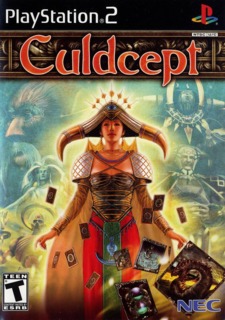Quirky, clever, and surprisingly addictive; Culdcept will appeal to fans of many genres.
Each battle takes the form of a board game in which the players roll dice and move around a board of various colored squares. Much like in Monopoly, the players claim territories, levy taxes on opposing players who land on their properties, and receive rewards for passing “Go” (or in this case, the castle). The first player to obtain a specific amount of magic power, the game’s currency, and return to the castle wins. What differs from traditional board games is the way that these territories are gained. Each Cepter has a deck, or book, of cards with which they must claim and defend their territories. To obtain a property a Cepter must summon one of the creature cards from his book to defend it. When an opposing player lands on an occupied space they may either pay a toll or summon a creature card of their own to attempt to take the territory by force. In addition to the creature cards, there are spell and item cards which can be played on both creatures and Cepters—like the item Chain Mail which adds 30 to a creature’s HP, or the spell Fly which allows the user to roll an extra die.
The sheer number of cards and possible combinations gives the game both a depth of strategy and a compelling reason to continue playing. At the end of every battle, whether you win or lose, you receive new cards for your deck; so even after a loss you have the opportunity to improve your deck which keeps a lost match from feeling like a waste of time. As one deck can only contain a maximum of fifty cards, the number of routes a player can take when developing his personal style of play is nearly limitless. In addition to the basic creatures, spells, and items; there are a number of other effects that can come into play including critical hits, elemental properties, and special goal squares.
The AI you play against gets gradually better as you progress through the storyline, just enough to keep things interesting, but without becoming frustratingly difficult at any point. The AI characters gain finesse in the use of their cards as well as gaining stronger cards. However, the AI suffers from a few slight snags, the most noticeable of which is its speed. It uses the same menus as the player characters, but sometimes it flies through them so fast the player can’t tell what spell is being cast or what effects it will have. Since sometimes the AI has cards the player hasn't seen before, this can get frustrating.
Culdcept’s presentation is as strange a mix as its gameplay. The animations and backgrounds are quite simple, but everything is crisp looking and the colors are bright. The 2D character sprites are cartoonish, rather like characters from a Nippon Ichi game, and each of the hundreds of creatures has its own unique, animated sprite on the game board. The overall effect is understated but attractive. The cards, in direct contrast, are beautifully handpainted illustrations by various Japanese fantasy artists. Some of the spell effects are fun to watch and the card battle animations – in which the cards literally smack, slash, and burn each other – are a particularly nice touch. The contrast, which seems extreme on paper, works well in the game as the cards save the sprites from seeming too cutesy, and the 2D style of the main game prevents the high-fantasy artwork on the cards from feeling too pretentious.
Another nice touch is the narration. There are two narrators in Culdcept, a male voice which makes various announcements throughout the game, and a female voice which has only a few lines, usually about the characters’ progress on the game board. These voices are the only spoken words in the entire game, and although the total lack of voice acting in the cutscenes is disappointing, the narration sounds polished. The same cannot be said for the game’s soundtrack, which is rather hit-or-miss. Some of the battle music is monotonous, the battles can be long and the continuous looping of the shorter tracks will grate after a few repetitions. Additionally, several of the tracks sound out of place and break the mood. In one instance an upbeat tune plays while the player defends himself against a murder accusation. These problems, fortunately, are the exception, rather than the rule. The main theme is evocative, and most of the music is pleasant, if unremarkable.
Culdcept offers multiplayer for up to four players, with the option for each to load his own personal deck, and this multiplayer mode is even more addictive than the single-player. Options are offered to customize the length of the game and conditions for victory, and players are also given the opportunity to add AI characters to a multiplayer battle. There is no support for online play, but like all good board games, it is extremely engaging to play with friends in person.
Despite its seemingly bizarre concept and a few dry moments, Culdcept’s solid gameplay and excellent replay value make a truly charming whole. With a multitude of cards to collect, Culdcept will appeal to gamers who enjoy finding every item in a game; but with each episode lasting around an hour it is also the kind of game that can be satisfying even if only played a few times a month. It's easy to learn, but much tougher to master. It will interest fans of strategy games, card games, board games, and role-playing games alike. If you’re looking for a game with a lot of personality, Culdcept could be for you.

